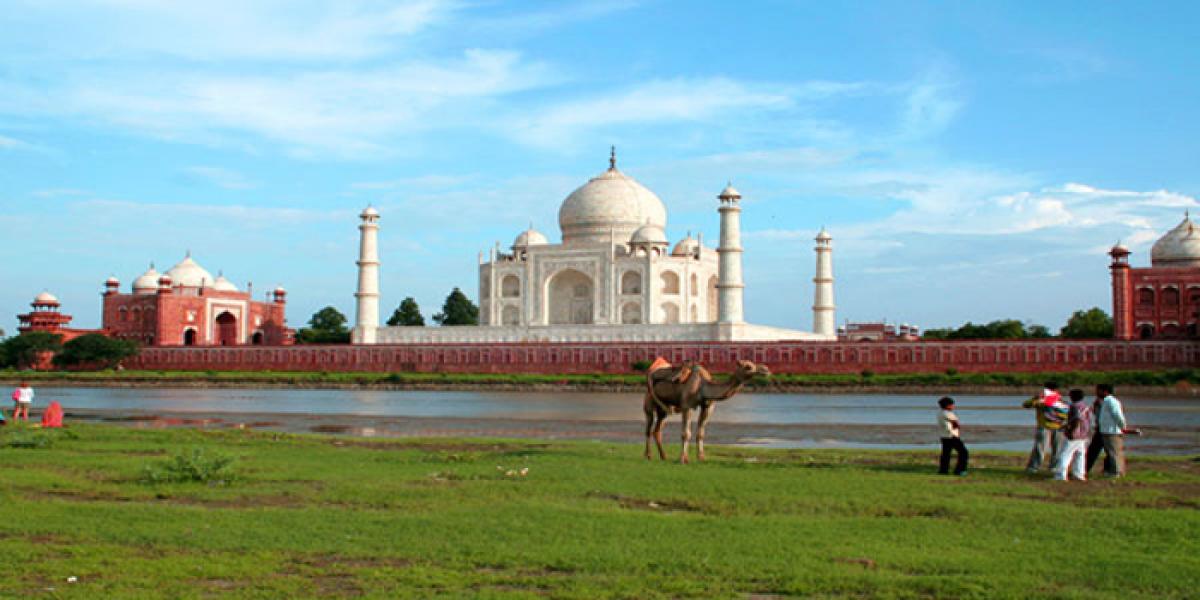Live
- GMR Airports Unveils AI-Powered Digital Twin Platform to Transform Airport Operations
- India poised to become leading maritime player: PM Modi
- Top Causes of Kidney Stones and How to Recognize Silent Symptoms
- India’s renewable energy capacity logs 14.2 pc growth at 213.7 GW
- Winter Session of Odisha Assembly adjourned sine die
- Biden calls Trump's tariff approach 'major mistake'
- After Drama Over Eknath Shinde’s Chief Minister Race, Maharashtra Cabinet Formation Faces New Tensions
- Egyptian FM, Blinken discuss recent developments in Syria
- Iran's supreme leader says Syria's developments result of US-Israeli 'plot'
- Elon Musk to Purchase $100 Million Luxury Mansion Next to Donald Trump's Mar-a-Lago, Report Reveals
Just In

Taj Mahal Perhaps The World\'s Most Photographed Monument. The Taj Mahal in Agra is perhaps the world\'s most photographed monument. Each minute hundreds of cameras click to shoot memorable photographs.
Agra: The Taj Mahal in Agra is perhaps the world's most photographed monument. Each minute hundreds of cameras click to shoot memorable photographs.
.jpg)
"It's a matter of pride to be photographed with the Taj Mahal," Denis, a tourist from Australia, told IANS.
These days, with almost every one in possession of a mobile or a digital camera, you can see people taking selfies or posing for a group photograph with friends or relatives. Now with the Taj Mahal getting its own Twitter handle and the monument complex equipped with WiFi facility, no one misses the once-in-a-lifetime opportunity to shoot and share.
The Taj has not lost its charm. It continues to remain the delight of photographers from all over the world. Lonely Planet's 'ultimate travel list' includes the Taj in the top five tourist destinations in the world. The Taj Mahal is annually visited by over six million people. Unofficial figures are 10 million, as children below 15 do not have to purchase a ticket to enter.
Each day hordes of photographers - both amateurs and professionals - shoot pictures of the white marble mausoleum, bringing joy and excitement to those who pose against its backdrop. "Many feel it's a fulfilment of a long-cherished dream," Amit Sishodia of Agra Beats travel agency told IANS.
"It's the architecture, the perspective and the unique backdrop that includes the Yamuna and a whitish skyline that appears to extend to eternity that I find most appealing," city photographer Hemant told IANS.
Ramesh Chandra Khandelwal, 90 plus, Agra's oldest photographer who runs the more than a century old firm of Priya Lal and Sons, said the Taj Mahal will never lose its fascination and awe.
"It is one building with immaculate, Nayaab dimensions, perfect lighting conditions, such variety of angles and contrasts, what else could a photographer want? And if you take into account its history and the romanticism associated with it, who would not like to be photographed with it," Khandelwal told IANS.
Wildlife photographer Lalit Rajora, who began his journey 18 years ago from the Taj Mahal, still cannot delink himself from the grand Mughal monument.
"The grand Taj Mahal, with its enticing beauty, has an eternal fascination for me. Its aesthetic beauty, pristine craftsmenship and grandeur attracts me as a photograph does. As a photographer, when this attraction coverted into an unfading romance and passion is difficult to tell. All I can say is that the Taj, under the seasonal hues of the sky enkindles my soul, gives wings to my imagination and meaning to my expression and creativity," Rajoria waxed eloquent while speaking to IANS.
Vijay Goyal, owner of the Speed Colour Lab, who spent 20-odd years at the Taj Mahal shooting pictures for tourists and VIPs, told IANS: "I recall the statement of a lady tourist long back. She reacted: 'Oh my god, this looks much better than the photograph I saw back home'."
Goyal said the Taj Mahal faces south. "The sun rises from the east on the left and traverses the whole distance to the right (west) providing different contrasts, shades and colours - never a dull moment. Each angle is different, its symmetry and geometry is perfect and flawless. There is a mix of colours - red sand-stone juxtaposed with white marble and a profusion of green vegetation, while the shades of blue and white. Rare is a man-made structure in the world that provides such a spectacular variety and mind you, there is no artificial lighting anywhere as for the Eiffel Tower or many other monuments."
Vishal, a photographer and owner of the Nice Studio, one of Agra's oldest, told IANS: "Every day, every hour, every season is different. The white marble mausoleum reflects nature's varied moods. People see romance and poetry in it. The beauty of the Taj Mahal lies in its totality, not in parts. The framed portrait - like the view from the main entrance - has been compared to a veiled bride. The mystery of the Taj's beauty will never be fully explained. The colours of Jannat have been used to weave intricate patterns and layouts, the fountains, the green shrubs, the natural skyline ...you look at it from any angle, it's a manifestation of beauty and no wonder many say it's a divine monument."
"Even the visitors in their thousands coming daily are part of the Taj Mahal, adding colours and flavours of a cosmopolitan nature, as if the whole world is represented here in a miniscule. The tranquility and the awe that one feels gives it a special status. The Taj is a living and breathing monument, you can feel it," 72-year-old Surendra Sharma, who is associated with the Fine Arts Studio, told IANS.
"Now, of course with advanced technology and camera-fitted mobile phones, everyone is a photographer, but there was a time when with primitive cameras and shooting in black and white, the real essence of photography was brought out and memorable pictures were taken," Sharma addded.

© 2024 Hyderabad Media House Limited/The Hans India. All rights reserved. Powered by hocalwire.com







